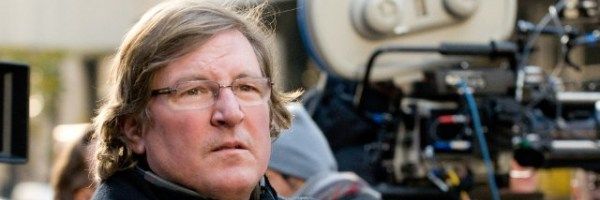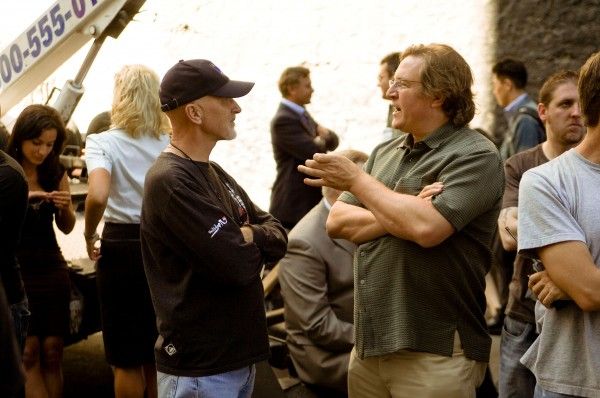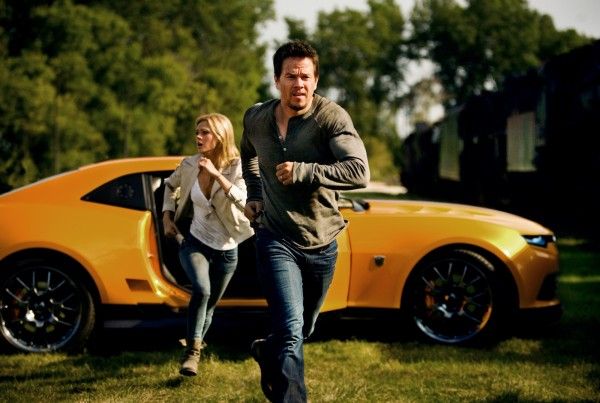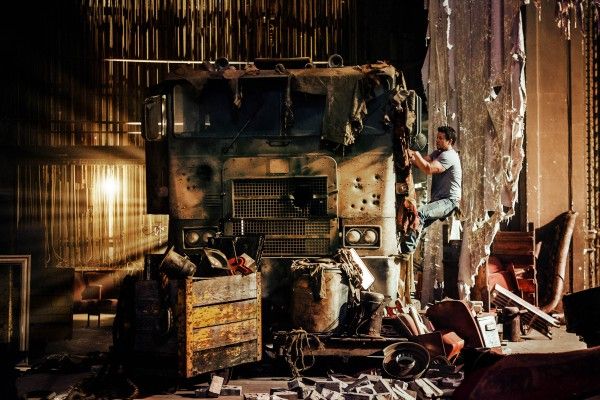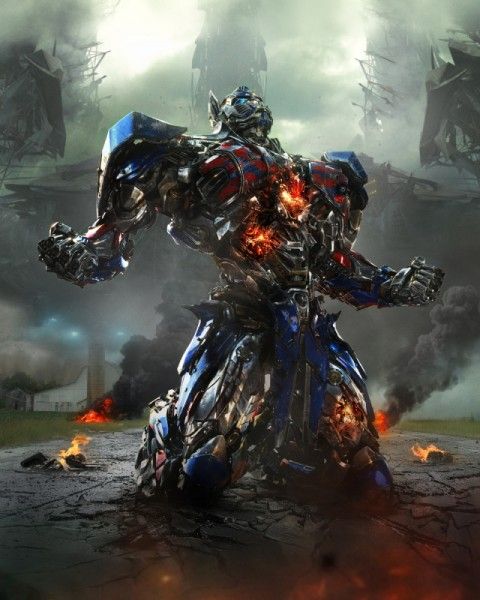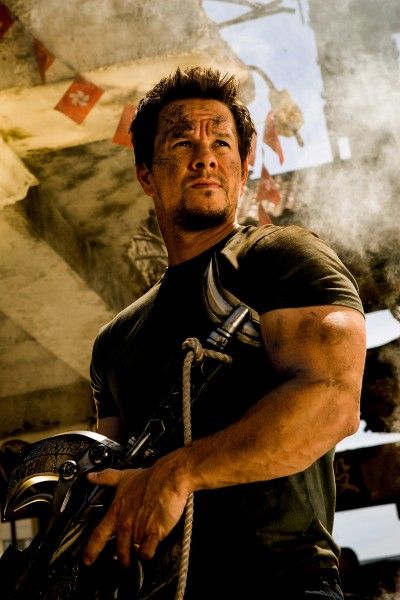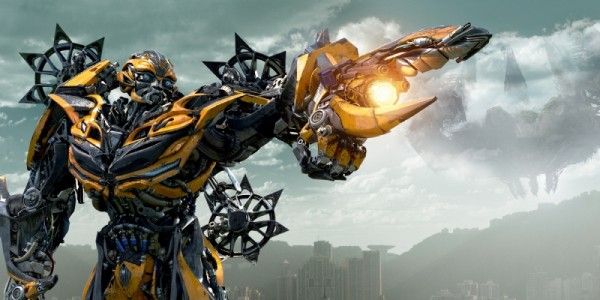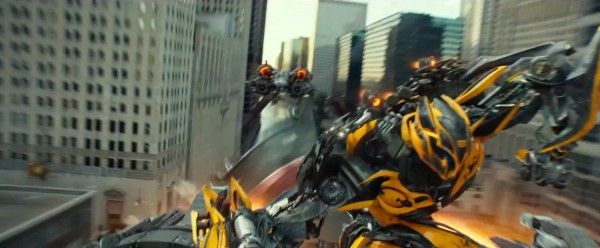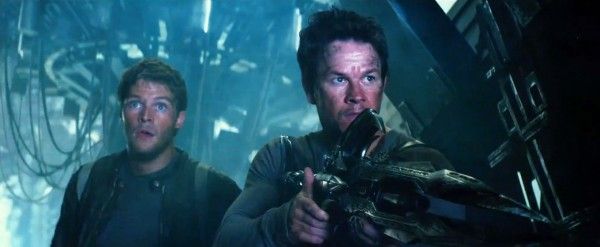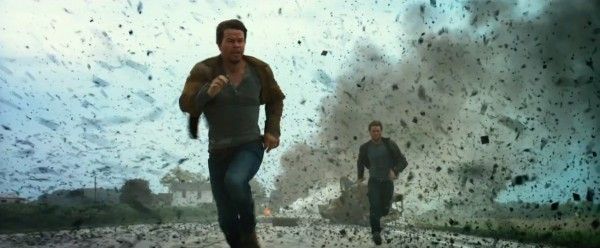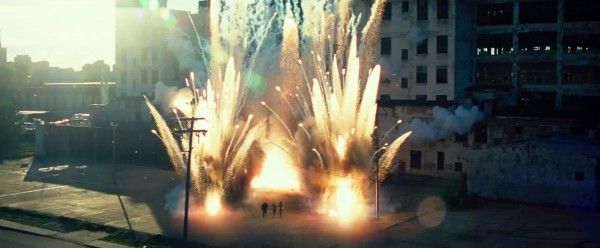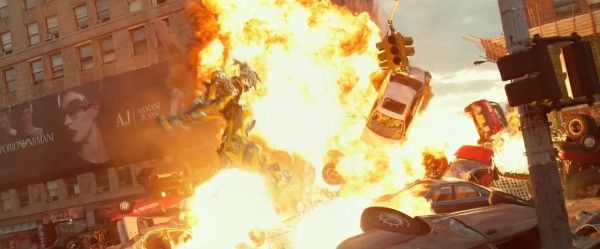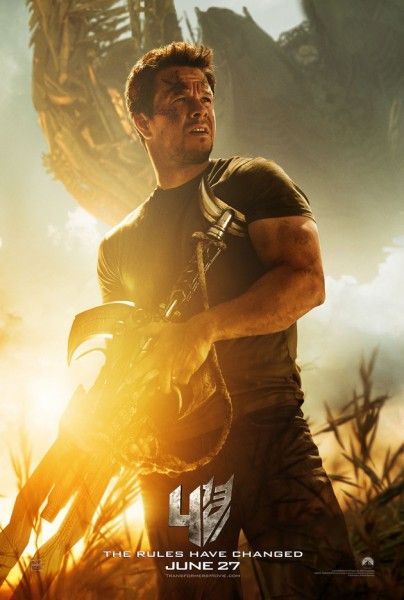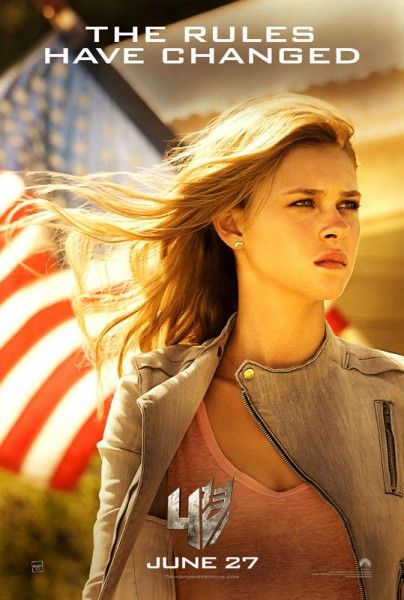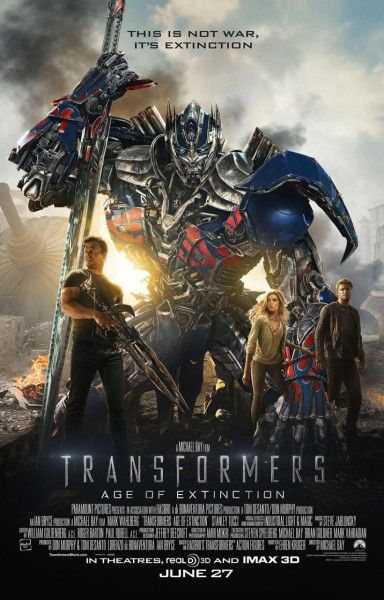Veteran producer Lorenzo di Bonaventura has been with the Transformers franchise from the beginning, and with Michael Bay's Transformers: Age of Extinction opening soon, neither of them shows any signs of slowing down. While on the Detroit set that acted as a stand-in for Hong Kong, I joined a small group of journalists in witnessing a huge action scene unfold, along with cast and crew interviews between shots. One such interview (and a rather long one at that) was with all-around-awesome producer, di Bonaventura.
He talked about the preparation for these action sequences, how scenes in Hong Kong and China were always part of the script, what makes this film different from the others and yet still a continuation of the franchise, and referencing the previous movies. In his more candid moments, he shared a few anecdotes about working with Bay and commented on just how great their working relationship really is. Hit the jump for much, much more.
Lorenzo di Bonaventura: We’re off to kind of a slow start. It’s amazing the amount of preparation that goes in, it’s like … as many big action scenes as I’ve done, every time it’s like, “Oh that’s right, we have to go really slow and make sure every single element…” Last night, we started a lot of this destruction, and it takes a long time to get it going. You can see right now they’ve got something up on that stage, something we’re gonna blow today.
So we’re seeing them set up a bunch of stunt boxes and we’ve got smoke going off over here … can you tell us what we’re setting up for?
Di Bonaventura: Well, we’re in Hong Kong, and one of the interesting things about this movie is that a lot of people do Chinese co-productions, and I don’t even know if that’s the right word anymore, but we worked with the Chinese together, but they like re-engineer the movie? We have engineered it this way first. Michael had a specific vision of how he wanted a city that has a horizon where certain things can happen, and Hong Kong was actually the logical place for it. A large part of the movie will take place in mainland China … more in Hong Kong, and some in mainland China.
This sequence is the third act. All hell’s breaking loose. You’re gonna see … in this movie, we always try to hide as much information as possible, but in this movie, there are going to be more than two elements fighting at this point, and that’s all I’m going to say. You know, in Chicago it was a two-way battle; this is kind of a … it’s still a two-way battle, but there are a lot more different elements at play. So this sequence is [when] they’ve realized just how desperate it’s gotten, and bad stuff is really going to start happening right about now.
How different is this film from the previous three?
Di Bonaventura: It’s a lot different in many ways, and it’s also the same characters you know. I think what’s interesting is, I can’t think of a movie – maybe you guys can – I can’t think of a movie that’s doing what we’ve done. Look at Star Wars, they’re continuous, you’re following each character as they grow older, right? Well, Optimus and Bumblebee are joining us for this trip, so they’re characters you know and love, but it’s a completely new chapter. Like, nobody from the original cast is in other than our Transformers, honestly. So, I’m not quite sure what … People have said it’s a reboot. It’s not a reboot. We have Batman and Superman coming together, you know what I mean? And yet, it is a completely new movie. I think what’s really a big and important difference for us, is [that] in the first movie, there was this triangle that kind of bound the movie together, which was Shia and Megan and Bumblebee, right? Now we have a human triangle that’s meshing this movie together, and I think it’s giving the movie a real solid base, so that’s obviously Jack, and Nicola, and our friend Mark Wahlberg. And also with Mark being an established movie star, as opposed to Shia being an up-and-comer, there’s a different vibe to it, you know? It’s like, you see movie-star shots in a way that remind me of having done movies with Kevin Costner or Bruce Willis, you’re like, “Oh yeah, that’s right.”
So it has a different texture to it. So I think the triangle is keeping the story unified throughout the movie. And I think also because Mark’s older … one of the biggest struggles for us has always been, how do you keep a six-foot human relevant against these 30-foot things? Well we found it in this case, and it’s partly because Mark’s just older, and you’re going to believe that an older character can do things that you’re not going to believe a high-school character can do, you know? And so I think that’s helped to unify the movie as well. I think it has a real cohesion and it feels very new. Plus, we don’t get to see Optimus and Bumblebee until later on, too. We’re living just in this part of the movie.
How much do you guys acknowledge, even just sort of in the conception of this, the first three movies?
Di Bonaventura: It’s a continuation for sure. For sure.
So you don’t have to do another origin?
Di Bonaventura: No, this is post-Chicago.
Will we hear anything about the original human characters?
Di Bonaventura: That’s a debate that’s going on still. We love the Witwicky character and all the characters, but the movie’s really about these new characters, and so we’re trying as much as possible to make it about these new characters. I think also one of the interesting changes is, the Transformers’ innocence is a little different after the third movie, you know? They were kind of abandoned by humans; they were sent to outer space. They have a little more guarded quality about what humans are going to do or not do, so I think that’s really a nice thing, too. It gives them a new shade.
Can you talk a bit about how the humans interact with the Autobots and how that relationship sort of intertwines with the other films?
Di Bonaventura: I think it’s similar to the other movies, in a sense. You will see that kind of interaction. It will be with different characters doing it, and so the dynamic is different, you know? It’s interesting just reading the dialogue between Optimus and Wahlberg. It reads differently. It’s a different dynamic. So I think what people really enjoyed about them was… it’s there, but it’s different now again, because they’re dealing with different people.
Can you say if it’s like a war movie, or an alien movie, or an action movie, or all of the above?
Di Bonaventura: Well it’s kind of all of the above. [laughs] I think what’s fun of making a Transformers movie is that it gets to be all of the above. I think, thematically, this movie is … because of the third movie, you can ask questions in this movie you couldn’t ask in the previous films. Like I was referring to the fact that they were abandoned by humans in the previous film; their attitude is different, so we’ve been able to tackle different themes. But fundamentally, I don’t think of it as an alien-invasion movie; everybody’s here, kind of, right? So, I think it’s probably more of an action-adventure picture, if I actually had to qualify it. This movie … we’ve shot in Washington state already; Monument Valley; Austin, Texas; here; Chicago; we’ll be in Hong Kong, we still haven’t determined how many different places we’re going to shoot in mainland China, it depends on which place can do what. So it’s going to have that sense of an action-adventure, moving around.
Are the robot designs any different? You said this wasn’t a reboot, so are they relatively the same?
Di Bonaventura: Well you know Michael’s not going to sit on his laurels. No, they’re definitely new and improved. Yeah, you’ll recognize them. They’re not dramatically different in that sense, but there are new looks, new cars, new stuff. And you’ve seen a lot of the new cars online, so there are a lot of interesting characters that come out of that. One of the fun things, the other day we were trying to come up with a name for one of the characters; we tried to think about what the car looks like, what the personality of the Transformer is, and then try to come up with a name that somehow reflects those two things.
So you’re no longer pulling from the toy line? You’re creating your own?
Di Bonaventura: We’ve never pulled from the toy line. We’ve always pulled from the mythology. What’s great is there’s so much mythology, so there’s always stuff to pull from that. It never lines up perfectly for a movie; it’s just like adapting a book or anything else, you know? But you come up with things to create, you come up with different ideas, but fundamentally the ideas always start from the mythology. Usually we start by going to Hasbro and sitting down with all the guys. There’s a group of guys there that are so completely into Transformers, and they’ve got this giant bible of stories, and then they tell us all the favorite stories. What’s always funny is, they put forth some stuff, we always pick some stuff, and then you look over there and go, “What’s that character?” And they go, “Oh it’s not that important a character.” And we’re like, “Well, that’s kind of a cool name, ‘The Fallen.’” “The Fallen” was a perfect example where we’re like, “That’s just a cool name.” So it’s always a mutual thing when we start, and then you take those elements and you try to do something that’s exciting. Michael wants to push the boundaries each time, so he’s pushing narrative in a lot of different directions.
Will there be an in-film narrative about the design changes? Will we see a scene that explains that or is that something that kind of starts out the film?
Di Bonaventura: You’ll see some work being done, but it doesn’t really go and try to explain that. It’s like the other films … we made improvements in each film. I can’t remember the number of pieces, but the number of pieces of a transformation from the first film to the third film got quantumly more complicated. I don’t know if we can get it more complicated, I’m sure Scott Ferrar, who you guys will talk to, can tell you how much more complicated it’s getting. I think one of the advantages of us sticking together for so long is that as long as you have somebody like Bay who’s not going to settle for what’s been done before, when you have a group like that, already all these lessons have been learned so you can keep pushing it each time, you know? Like even this sequence, I’m sure that ultimately how the Transformers enter the scene, how they react to things, it’s moved forward.
How would you characterize the tone of this movie? Because the first three got progressively darker. Is it more focused on destruction or fun?
Di Bonaventura: It’s funny, I don’t think of the first three as getting progressively darker. I guess that’s true, but I don’t really think of it that way. Is it less dark than the last one? Well…
I guess, is there a lot of fun to be had?
Di Bonaventura: There’s a ton of fun. There’s a ton of fun. There’s a lot of funny new characters we’re going to introduce. I think this movie has almost more in common with the first movie than any of the others in that it has a really strong space of human interaction that’s driving the beginning of the narrative of the movie and that stays with it all the way through. I think in that sense it’s not as dark as the others. It’s as big and bombastic in places and of course the world is threatened, so it has its dark moments I guess. No, I’d say the first movie is a better indication tonally of where we are.
I love how the movies work in actual historic events. Will we see that happening in this one too?
Di Bonaventura: We’re working a little bit on that, yeah.
Flashbacks?
Di Bonaventura: Well, I don’t know if we’ll do flashbacks or not, but the Chicago sequence is so memorable that that has real resonance within the story, if nothing else as a cautionary tale that a lot of characters are being driven by. In a way that’s the biggest reference point for the movie is, “Remember Chicago.”
Like the moon landing and …
Di Bonaventura: Yeah, we’re working on a few things.
When you say “funny new characters” do you mean funny new humans and funny new robots?
Di Bonaventura: Yeah there’s new humor for the characters, and the human interaction is really fun. I think Mark is one of the great underestimated actors. He’s such a good actor and he’s so funny. Shia was funny, too, so it’s just a different kind of funny now. Stanley Tucci’s bringing a different color to it, Kelsey Grammer brings a different color to it. Michael doesn’t get enough credit for how funny he is, because if you look at all his movies, there’s [a lot of] fun in them. I get that the spectacle kind of overwhelms everybody’s perspective of who he is, but the truth is, in humor, he’s pushing the envelope. He encourages the actors to go for it, and so we’re trying to find that balance all the time; if you make it too funny then it starts getting silly, but he’s willing to push the boundaries toward silly too, because he really falls in love with certain characters, like Brains in the last movie. He just really loved that character, cracks him up, you know?
You mentioned Stanley Tucci but we don’t know too much about his character. Can you comment on how his character folds into the film?
Di Bonaventura: Well, without revealing too much about him, and I know you’re going to talk to Stanley so I’m sure he’ll fill in, but we need adult authority figures to both do good and bad in these movies, you know? And he’s one of those characters who’s capable of both. That’s what I love about him as an actor, we’re actually playing to some of his strengths because he’s that guy who can be so … and then also be so funny. Yesterday, there was a moment there where, just in the middle of the mayhem, he made this funny line which was said pretty straight, but it just cracked everybody up. It was like, “Oh, okay, here’s where we are.” I think it’s a real advantage putting in a new cast, too. We loved our cast, but what’s great is, for us, we honor what we’ve done, but in a sense it has nothing to do with it now, you know? It’s a continuation in that way and it’s a new chapter.
So, off of that, is it more of an escalation because of the events in the last movie, or is it a new beginning? What’s the Autobots’ take on that?
Di Bonaventura: That’s an interesting way … It’s a combination of a few things. I look at it and I think it’s more attitudinal than verbal, that they have a slightly more jaded sense of humans, if you would, right? So it’s not like they’re sitting there going, “Oh, these humans,” but they’re a little more reticent to trust. I loved, and I think it’s some of the reasons we love Optimus and Bumblebee in the other movies is because they’re so utterly on our side, right? Well, they still are, but they’re also kind of a little bit like, “All right, which kind of human are you?” I think it’s an interesting thing. They’ve evolved, and I think that’s sort of fun. Bumblebee’s still sort of an incorrigible teenager sort of thing, and Optimus, if nothing else because of Peter’s voice, is the voice of authority; you can’t get away from those parts and we wouldn’t want to get away from them. But they have evolved, and they have a slightly different attitude about humans.
How does the Decepticon threat come into this film? How does it enter?
Di Bonaventura: Well, as I was alluding to, there are multiple threats. One of the things we wanted to have, and I think we succeeded a bit with Patrick Dempsey’s character was, how do you get human villains playing an active role? So, in this movie we’ll have some of that as well.
You mentioned that Optimus and Bumblebee don’t show up until much later in the film.
Di Bonaventura: No, I didn’t mean it like that. I didn’t mean to say that per se.
Okay, so they’re sort of still central…
Di Bonaventura: Oh, they’re absolutely central. I’m just saying, right from the get-go we’re solidifying the human dynamic in the movie so that it has the strength to last through the movie. I think that sometimes we struggle a little bit to hold on to it, and in this movie that is so solidified very early. But you’re not getting less of the Autobots.
How many of the Decepticons of the previous films will be making an appearance and how much will you be introducing new characters?
Di Bonaventura: You’ll see some new characters, but you’re going to have to wait. [laughs] The audiences will see the answer to that question. There are a lot of new characters in this movie. I think, if you’re making a new story, there are a lot of new characters.
If this movie were to involved Dino-Bots [laughs] how would you explain … [Editors note: This set visit occurred before even the title of the film was revealed, let alone the Dino-Bots.]
Di Bonaventura: I’ve been waiting for the Dino-Bots! [laughs] I don’t know, maybe Dino-Bots are going to be in there, or not. We’ll have to see.
If they’re in or not, how would you explain dinosaur-looking robots?
Di Bonaventura: [laughs] I don’t know, you know? I haven’t really thought about it. [laughs]
With the new cast and a fresh take, is this movie more of an establishment of maybe a new franchise or trilogy? Or is it a “last hurrah” type film?
Di Bonaventura: It is not designed to be a last-hurrah film, I’ll say it that way. When we made the first movie, we didn’t presume we were getting to do a second one. A lot of people think that’s how the filmmakers approach it, “Oh, we’re going to make a franchise and we’re going to get to a sequel.” I think every time you do that is usually when you get punched by the audience because somehow I think there’s an inherent arrogance to that. Both Michael and I know, we’ve talked about this, we both feel very strongly because we’ve both been involved in a lot of big movies, luckily, in our lives, it’s so hard to make one movie well, the idea of trying to think ahead is impossible. At the end of this movie, you could definitely have another movie. It’s not designed to be just, “Okay, the story’s over,” but we don’t spend any time thinking about the next one.
In the first film you actually created Bumblebee practically for one sequence. Did you do any of that for this film, or is it all CGI?
Di Bonaventura: We have elements of different things this time. There’s a lot of new interesting sets and things that are going to be surprising in terms of, we’ve gone a little bit more into … One of the amazing things I remember on the third movie, at some point in time I was talking to Ian Bryce, and Ian and I were going, “Man, how many people are working on this movie right now?” It was 1,450 people or something, so trying to keep track of the details and how many sets there are and … I will say that my impression of it is that we have built some more extraordinary things in this one, maybe more than we’ve done before.
The last film was an epic film, the budget was big…
Di Bonaventura: We’re very inexpensive. [laughs]
I feel like today is a more financially responsible time. Can you talk about how that affects things?
di Bonaventura: Well, there's no question you're right -- economic pressure on every film is more significant. Having done a billion-plus last time, it's not like we have the most stringent economic pressure on us. I do think Michael doesn't get credit for -- you know, it's really interesting, I didn't work with him earlier in his career, but when I was at Warners, I kept trying to get him to do movies. My perception on him was partly right, and when I came and worked with him, I realized I'd underestimated him. A lot of these movies, when you hear about them, you hear about how they shoot for 120 or 150 days, and they have a second unit that shoots for 50 days, 100 days. Right now, we're scheduled for under 100 days and no second unit. So Michael will do the entire thing in half the time that these other movies do it. So it's hard to look at the set and go, "We're an economically frugal group," okay? But the truth of the matter is, we do scale in an incredibly frugal way, because Michael's ability to master all these different elements efficiently -- you know, you'll watch him drive this set -- he's pushing everybody like, "Let's go. C'mon, let's go!" because he has an appetite for excellence, and he has a vision of what this thing's going to be, and he's going to go get it for us. That's the thing I find amazing. We sat there making each movie, and I'd kind of hear about, you know, "Spider-Man was $350 [million]," and we were like, "How do these guys spend all this money?" I don't get it, in a way.
You can't comment on it, but the first movie, what it was made for, is amazing compared to other blockbusters.
Di Bonaventura: I think that's right, and I think this is also, I'll say, to it's equivalent movies, we're less expensive. I don't want to sound like, "Hey, we're a cheap movie," because that would be false, right? But the reality is, Paramount feels really happy that this group of filmmakers feel strongly about maximizing budget, not just maximizing the size of the budget.
Is there a reliance on CGI more so on this one? Obviously there's a ton of CGI -- or do you guys gravitate to get as much practical work as you can?
Di Bonaventura: We are really a practical-oriented group. There is obviously CG because of the CG characters -- that we can't do. But at the same time, we'll do as much as we can possibly do. Thankfully, for me, Michael's taste is very similar to mine, so I love what he's doing, because I find when I see some of these movies, they have no sense of gravity because they have no sense of reality at all. It's just all created. I find, whether you can see that or not, I feel like there's a shadow of that when you watch something, you know? Pacific Rim, for me, when I watch that, I can't take it seriously. It just doesn't have any gravity for me. So that's what I like, is that we go about this thing in an incredibly practical way.
The films were obviously successful, but they sort of had a mixed critical reaction. Were there any specific lessons that you guys took from either the response of audiences or critics, or just looking at the end product and going, "Oh, these things didn't work quite as well as we wanted them to" that you applied to this film?
Di Bonaventura: Well, the unfortunate part of making big films is I think we're never going to get critical acceptance. It just seems to come territory. Particularly, critics seem to bash Michael. I don't get it. I don't think they really understand what he's doing -- and I think that's true for a lot of movies. These movies are meant to be fun. They're meant to "wow" you. They're meant to do certain things, and that's what they should be judging them on. They're trying to match it up against some of these movies that really have no relevance to what we're doing. I like '70s movies too, and I've made a few that resemble the '70s movies, but that's not what we're doing. I think that's true pretty much across the board. You look at Michael, he's never gotten great reviews. The audience loves what he does, and the critics don't. For me, I think Pain & Gain's a good example. I really liked Pain & Gain. I thought it was a wild story about these guys. Did he get good reviews on that? I doubt it. The critics, they just can't give him a break. So we don't really listen to that. We listen to the fans.
It's one of those things where you've got to find the proper balance. If you listen to too many people, you get confused. It's one of the reasons we always start with Hasbro. Yes, obviously it's their property and they're investing in their property, but the truth of the matter is, they're full-on geeks about Transformers. So we're starting with a core group of fans. We always try to use them in many ways as our blackboard, just trying to bounce off them and say, "All right, what do you guys think of this? What do you think of that?" They have some pretty clear instincts about that. You know, each movie you learn certain things about -- I do, anyhow; I'll say for myself -- each movie I'll learn something: efficiency, a different way to do a particular gag -- you say, "Wow, we tried that gag that way. That didn't work. Let's try it this way." So you do learn stuff along the way, for sure.
A couple technical questions -- are you guys shooting entirely in 3D on this one?
Di Bonaventura: You know what, honestly, I don't even know the answer to that. It's pretty much everything now. Maybe some of the handheld stuff isn't. I don't know. Those cameras have really improved. We've actually had a few cameras get destroyed so far.
Only a few?
Di Bonaventura: A little more than a few. I guess a "few" would be two or three, so in that case, no, more than a few. [Laughs]
Has Michael gotten more used to video?
Di Bonaventura: Video, yeah. That'll be the day. No, the cameras have gotten a lot better. The look is a lot better. You can see it. On the previous movie, we were restricted on doing certain things the cameras just couldn't do. So in that respect, they don't seem to have the same shake issue, which was going on in the first one. There's a lot of improvement. The depth, it's very interesting. Obviously, I'm sure -- I actually haven't asked Michael this question -- I'm sure he learned -- it was the first time he did 3D; I'm sure he's learned how to do it. The IMAX cameras are really incredible.
How much of the film is being shot in IMAX?
Di Bonaventura: I don't know percentages... A lot.
Would you say the 3D is more of the immersive experience, or are there going to be some of those pop-out moments?
Di Bonaventura: You know what, honestly, we haven't really talked about that. I think that's something you sort of decide in post. I'd have to ask Michael that question. I don't know.
What's your favorite Transformers movie?
Di Bonaventura: Well, I think the first one's my favorite because our child was born. You can never repeat that experience. I'm hoping this is the second child. [Laughs] I think it's very hard to differentiate them for any of us who've spent so much time -- I mean, it's close to a decade now, right? But you can never recreate that first date, that first surprise. I think in that respect, it will always be my favorite. I don't know if everybody else would answer that way, but for me, I think that's true.
How different is it working on this one versus the first one? Do you feel like you're jumping back into it fresh, or does it feel like you're keeping the old wheels turning?
Di Bonaventura: There's a lot of freshness going on. I think that's in large part because replacing the entire cast makes it feel like a new movie. I hope that's how the audience experiences it too. There's a whole new energy, and there's a lot of people who don't know what we're doing. They have to get up to speed with how we shoot, how we do this. There's a lot of newness. There's a little bit more of that "first date" feel, especially for all the new cast. Mark just did Pain & Gain, so it's not quite as new for him, but even so. I did Perfect Storm with him, and he hasn't done a movie like this in a long, long time. This is substantially bigger than that movie. So I think it has a newness to it. It's an interesting question. I was just talking to somebody about it this morning, you know, when you come into it, it's like, "Okay, we're going into the fourth. How is this going to feel?" I think we all feel kind of invigorated by that fact.
I love hearing stories about Michael Bay and how he works. Could you share one of your favorite Michael Bay stories?
Di Bonaventura: You know, I think there was a moment in Egypt, where a lot of people would have wilted in that moment in time. It sort of shows Michael's sense of perseverance. It's not necessarily the most colorful story. Can you imagine us making the second movie without the Pyramids? Okay, so we arrive in Cairo, and literally we're like, "Okay, we're in Cairo! This is exciting!" We're walking down the airport, and they come walking up to us as we're walking out of the thing, and they say, "Your permits pulled for shooting." A lot of people, who will remain unnamed, were like, "We're leaving Egypt. Let's go." Michael was like, "No, no, no. We're going to the Pyramids." We stayed in Egypt for about 48 hours, which -- all of us were completely nervous. We were really feeling the pressure of this thing like, "This is really a disaster," you know? Michael just said, "We're going to get the Pyramids. We're going to get these things. We're not leaving until we get the Pyramids." So we got the Pyramids. You know, there was a lot of financial reason to leave at that moment. Anybody involved in the cost of the movie was sort of like, "Maybe we should just go to Jordan and hope later on that this is going to happen," or, "We're going to think of something new for the ending." Somebody asked me yesterday, "What's it like working with Michael?" I find it completely adrenalizing, because he doesn't want to settle for anything. He really wants to push it. I know early in his career, you always heard these stories about the sets and all this. I find it really great. It's hard, because he pushes so hard. But I think the funniest thing about working with Michael is when I'm working on another movie, I'm bored so many times. It's like, "Really? We're going to move this slow? Can't we get this thing going on?" It's really strange. You get used to this kind of pace. A lot of people, when they first see it, they're like, "Wow!" I don't know. I find it kind of invigorating.
So the military had a huge presence in the first three films. Is that going to be continued in the fourth one?
Di Bonaventura: Less -- much less so -- in part because we're going to be overseas. Sort of like the end of two, they really weren't there -- a little bit, but... Here in Hong Kong, they're in a different part of the world. They have different superpowers there. It wouldn't have been appropriate I think to use American military. They're present in some respects, but nowhere near like in the other movies.
Are you sweating at all about the June release date?
Di Bonaventura: We're always on a tight wire. We're on an incredibly ambitious schedule. I think maybe the most luxurious might have been one, which maybe we had a whole month extra. So, again, we've created a working methodology that allows for a very stringent process. Going back to the cost question we were talking about before, one of the reasons why these movies are efficient is because we don't cut and edit and sit there for months and months or a year on end, right? We'll make this whole movie in essentially 18 months. When you really think about it, the really active part about it is probably 16 or 17 months. You know, there's a period of time when you're collecting illustrations and things, but it's a very small group of people, and it's a very creative thing in that point in time. We go up and start prepping in January, and we're done by the following -- and we're not really prepping until March, April. So we're making these movies in less than 18 months. You look at these other guys, it's taking them a lot longer.
When shooting with Michael, do you feel like there's a compulsion to go even bigger, to where like, you know, from the end of Transformers to the end of Transformers 2 to Transformers 3, like, the scope of the climax is always getting bigger and crazier? Is this one just going-for-broke, outer space crazy?
Di Bonaventura: It's hard to go bigger than the last one, I think, don't you? I don't know that it's conscious that we're going bigger. We're trying to give it more of a spectacle.
As you stand next to this. [Laughs]
Di Bonaventura: Yeah, I know. Look, I think going to Hong Kong is giving it a whole different color and texture. I think in that way that was sort of our sense of making it different. I don't know that we can be bigger than the last one -- I can't imagine it.
It doesn't need to be. It's just a question.
Di Bonaventura: Yeah, but it's big. It's exciting -- but it's new. It's a new environment to take them to. In that way, it has a very different texture. On the page -- it's going to be interesting to shoot in Hong Kong and feel it, you know?
You talked about working with Wahlberg and Tucci and the other veterans. Can you comment on some of the newcomers to the cast, the sort of up-and-comers?
Di Bonaventura: Yeah, Jack and Nikola are just real troopers. I'm really amazed at how quickly they've come attune to what we're doing.
It's a tough thing to throw them into.
Di Bonaventura: Yeah. No, it is, and they're both real troopers. We've actually been remarking about it -- they have maturity far past their year, that's for sure. That's really been a benefit to us. They jumped right into it, and they're both asked to do a lot physically, and they're asked to work long hours, and they're great. Their dynamic is really fun in the movie, and they're really good for the franchise.
Can you talk a bit about the Kelsey Grammer character? We obviously see Decepticons and how they play into it, but what about the human antagonism in this one?
Di Bonaventura: Why do you assume he's the bad guy? [Laughs] I think what's interesting to me is my perception of him was always sort of as this comedic character, you know? But there's a really tough, dark side to him. I think what's interesting is, we play different levels with that character. That character's not so black-and-white as you think it might be. He's a real pro. He's been around a long time. One of the interesting things I find when you work with a guy like that or Stanley or even now Mark -- you know, I've done six movies with Mark. He's actually a really good example. When I first worked with him, I think he adhered to the dialogue pretty much 100 percent. Now you're watching, he's lifting it. Ad-libbing I think sometimes has a negative connotation like, "Well, the dialogue wasn't good enough, so you need to do it." It's the understanding of the moment and that another reaction, another line of dialogue, may have more impact. I think that's the same thing with Kelsey or with Stanley. You get that freedom of confidence and sort of a deeper understanding of the moment. Ehren's written 'em some great lines, but it can lead to unexpected readings of them or unexpected new ideas. That's what's fun for me, you go and look at dailies and it's like, "Oh my God, look at that!" Also, there's so much going on, you're not always looking at the actor; you're looking to make sure the stunt was safe. So I find dailies sometimes incredibly surprising. You're like, "Wow, look what they did with that scene."
The first film is about the relationship between Sam and Bumblebee, by and large. With that being absent in this one, can you talk about how the role of Optimus and Mark Wahlberg's character fill in that void?
Di Bonaventura: I think there are two things going on in this film -- I think there was in that film too. I always think that the triangle of Shia, Megan and Bumblebee -- yeah, there's this personal relationship, but the triangle had a lot to do with solidifying it. The triangle between Mark, Nicola and Jack is I think the glue of this movie. There is a strong bond that will build between them and the Transformers, but for me that's the key one. It'll be interesting to hear people's different reactions, because everybody reads scripts slightly differently. It's interesting, I might not have said that after reading the script. I think I probably would have leaned that way, but when you actually watch it play out, you realize how strong it is. It's even stronger when it's being executed. So I find that's the key dynamic. Optimus and Bumblebee and Mark -- all three of [the humans] -- all five of them have a very strong thing going on. I don't think we have that same sort of one-on-one dynamic. There's some relationships between characters -- and the Autobots are stronger than others -- but the real strength of the movie is those three people really binding it. Mark being the oldest is, in a sense -- it's funny saying "the authority figure." He does tend to be the focal point of Autobots.
- 65 Things to Know About Michael Bay’s TRANSFORMERS: AGE OF EXTINCTION From Our Set Visit
- Michael Bay Talks TRANSFORMERS: AGE OF EXTINCTION, Working with Mark Wahlberg, Robot Redesigns, the New IMAX Camera, and More
- Mark Wahlberg Talks TRANSFORMERS: AGE OF EXTINCTION, Drawing on His Experience as a Father, Big Action Movies & Possibly Singing the Title Track
- Jack Reynor and Nicola Peltz Talk TRANSFORMERS: AGE OF EXTINCTION, Action Scenes, Character Traits, Working with Mark Wahlberg and Michael Bay & More
- Stanley Tucci and Sophia Myles Talk TRANSFORMERS: AGE OF EXTINCTION, Filming Action Scenes, Working with Michael Bay, and Their Favorite Bay Movies

